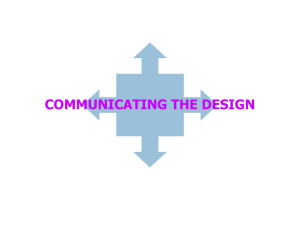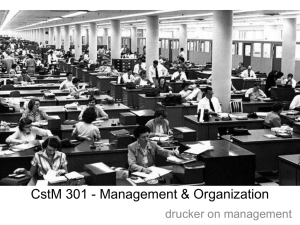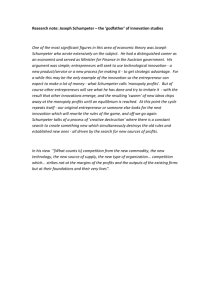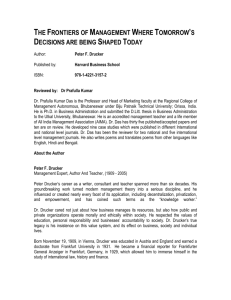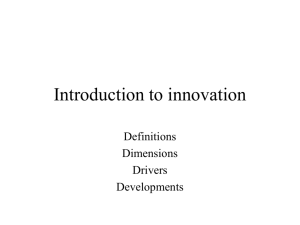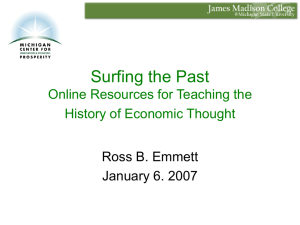On the Drucker Legacy
advertisement
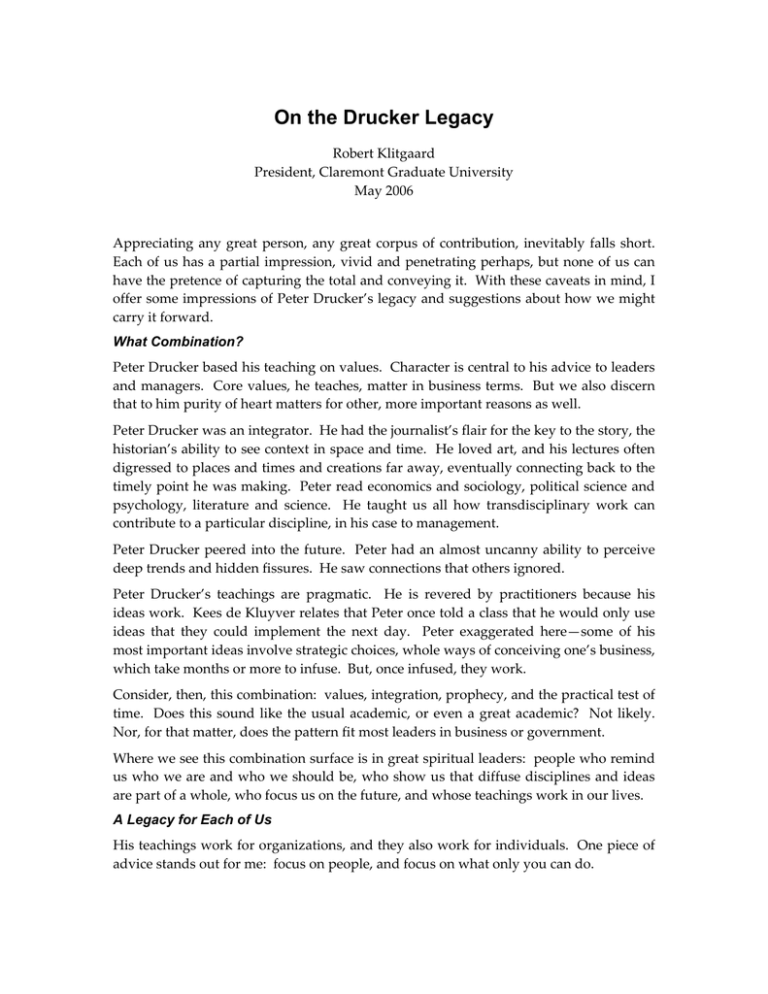
On the Drucker Legacy Robert Klitgaard President, Claremont Graduate University May 2006 Appreciating any great person, any great corpus of contribution, inevitably falls short. Each of us has a partial impression, vivid and penetrating perhaps, but none of us can have the pretence of capturing the total and conveying it. With these caveats in mind, I offer some impressions of Peter Drucker’s legacy and suggestions about how we might carry it forward. What Combination? Peter Drucker based his teaching on values. Character is central to his advice to leaders and managers. Core values, he teaches, matter in business terms. But we also discern that to him purity of heart matters for other, more important reasons as well. Peter Drucker was an integrator. He had the journalist’s flair for the key to the story, the historian’s ability to see context in space and time. He loved art, and his lectures often digressed to places and times and creations far away, eventually connecting back to the timely point he was making. Peter read economics and sociology, political science and psychology, literature and science. He taught us all how transdisciplinary work can contribute to a particular discipline, in his case to management. Peter Drucker peered into the future. Peter had an almost uncanny ability to perceive deep trends and hidden fissures. He saw connections that others ignored. Peter Drucker’s teachings are pragmatic. He is revered by practitioners because his ideas work. Kees de Kluyver relates that Peter once told a class that he would only use ideas that they could implement the next day. Peter exaggerated here—some of his most important ideas involve strategic choices, whole ways of conceiving one’s business, which take months or more to infuse. But, once infused, they work. Consider, then, this combination: values, integration, prophecy, and the practical test of time. Does this sound like the usual academic, or even a great academic? Not likely. Nor, for that matter, does the pattern fit most leaders in business or government. Where we see this combination surface is in great spiritual leaders: people who remind us who we are and who we should be, who show us that diffuse disciplines and ideas are part of a whole, who focus us on the future, and whose teachings work in our lives. A Legacy for Each of Us His teachings work for organizations, and they also work for individuals. One piece of advice stands out for me: focus on people, and focus on what only you can do. On my desk I keep the last two pages of a twelve-page letter Peter Drucker wrote to a friend of mine some fifteen years ago. Peter had spent the first ten pages giving advice related to the institution my friend was creating. Those last two pages contained advice about my friend’s role as leader. Peter wrote about my friend being “the maker of policy and the designer.” He also mentioned quality control. “But as I tried to stress, your first role—or perhaps one of the two first ones—is the personal one. It is the relationship with people, the development of mutual confidence, the identification of people, the creation of a community. This is something only you can do.” Peter went on. “It is not something that can be measured or can be easily defined. But it is not only a key function. It is one only you can perform.” What Does It Mean to Extend a Legacy? If these are some of Peter Drucker’s legacies, how might we carry them forward? This question suggests a prior one: what might it mean to carry forward a legacy? As warm-up exercises, consider two analogies. Eames One is the relationship of the Herman Miller, Inc. with two of its great designers, Charles and Ray Eames. Herman Miller is carrying forward the Eames design legacy. Here is how the company describes that legacy: With a grand sense of adventure, Charles and Ray Eames turned their curiosity and boundless enthusiasm into creations that established them as a truly great husband-and-wife design team. Their unique synergy led to a whole new look in furniture. Lean and modern. Playful and functional. Sleek, sophisticated, and beautifully simple. That was and is the “Eames look.”1 Herman Miller carries forward the legacy in several ways. The company continues to produce Eames’ classic designs. But most of their products are brand new. They do not ape Eames’ designs, but one can say that often they are inspired by Eames. One of Herman Miller’s new classics is the Aeron chair. describes the creative process and the design achievement: Note how the company Herman Miller turned to designers Don Chadwick and Bill Stumpf to design a totally new kind of chair. Chadwick’s and Stumpf’s previous collaboration had produced the groundbreaking Equa chair. The two designers began this development process with a clean slate, with no assumptions about form or material, but with some strong convictions about what a chair ought to do for a person… 1 http://www.hermanmiller.com/CDA/SSA/Designer/0,,a10-c80-b5,00.html 2 Although it reveals … organic forms that recall the work of Charles Eames, and a spare, athletic aspect that brings to mind its designers’ Equa chair, the Aeron chair finally looks only like itself. Its unique form expresses its purpose and use and the material composition of its parts and the way they connect.2 Schumpeter The second analogy is from economics. Joseph A. Schumpeter and Paul A. Samuelson were about as different as any two world-class economists can be. • Schumpeter, the master of the big picture, of historical forces and cycles, an admirer of mathematical methods but not really a user or developer of them. • Samuelson, the Nobel prize-winning theorist and innovator in the application of mathematical techniques to economics. And yet Samuelson proudly referred to himself as Schumpeter’s student, thought of himself as carrying forward what he learned from his master; and Schumpeter was proud to be called Samuelson’s teacher. Samuelson didn’t copy Schumpeter, didn’t provide an exegesis of Schumpeter (except a paper or two on Schumpeter’s theory of interest rates), didn’t proclaim the master’s teachings. In what sense, then, might we say that he was carrying forward the Schumpeter legacy? Earlier this year I wrote Samuelson and asked him. He is now 91, still at MIT and still writing (sound familiar, Drucker fans?). Samuelson replied, first with fond memories of Claremont, then with some remarks about Schumpeter. Schumpeter was a mentor of mine in the last 15 years of his life. I believe that, ten days before his 1950 death, I was the last economist to chat with him at length… He thought well of me and was very supportive. I valued his creative insights and erudition. Paradoxically, Schumpeter’s reputation and citation frequencies are greater fifty-five years after his death than they were back in depression days.3 Note the keys of their relationship: regard, support, insight, erudition. Schumpeter encouraged Samuelson, even to be different than Schumpeter. In a recent paper, Samuelson wrote, “As far as my own career was concerned, he egged me on to discover and utilize new mathematical tools in economics—even though, Moses-like, JAS himself was never to cross over into the Promised Land of Pareto, Hotelling, Tinbergen, and Frisch—to say nothing of Arrow, Debreu and Koopmans.”4 And in a 2 http://www.hermanmiller.com/CDA/SSA/Product/0,,a10-c440-p8,00.html Letter of January 30, 2006. Later in the letter, by the way, Samuelson wrote, “Peter Drucker was unique and important. Whereas Schumpeter was an economist’s economist, Drucker’s was a wider audience …” 3 Paul A. Samuelson, “Reflections on the Schumpeter I Knew Well” Journal of Evolutionary Economics, Vol. 13, No. 5 (Dec. 2003), p. 465. 4 3 much earlier article, published a year after Schumpeter’s death, Samuelson paid tribute to the legacy left by Schumpeter as his teacher. “Though Schumpeter left behind him no band of zealots bent on differentiating his views from those of traditional economic theory, he did leave behind him the only kind of school appropriate to a scientific discipline—a generation of economic theorists who caught fire from his teachings.”5 Drucker on Who Could Carry Forward His Legacy Before Peter Drucker passed away, I mentioned the Schumpeter-Samuelson analogy to him. The occasion was a visit to his home a year or so ago, when I was still president-elect. Peter was cordial and welcoming. We talked a bit about the Drucker Archive, and of the idea not only of capturing his work but also extending his philosophy, principles, and approaches into the future. I brought up the relationship of Samuelson to Schumpeter (without having then Paul’s letter and without my having found the two articles cited above). Peter said he knew his countryman Schumpeter and also knew of his close relationship with Samuelson. He made a few remarks about Schumpeter’s economics being historically based and Samuelson’s contributions being mathematical. I said that it would be difficult to imagine two great economists who were on the surface more different than Schumpeter and Samuelson. And yet, Samuelson saw himself Schumpeter’s student, somehow carrying forward his legacy. “There can only be one Joseph Schumpeter,” I said. “Just so, there can only be one Peter Drucker. But can you think of someone who might help carry forward your legacy, in the Samuelson-Schumpeter analogy?” Peter launched into fifteen minutes of ruminations. He opined about economics and its schools of thought. Then he talked, humbly but realistically, about some of the unique aspects of his work. He mentioned his interest in history, in big trends; also in practical applications. At the end of the fifteen minutes, Peter demurred. “I don’t keep up with the literature well enough to say who might be such a person. Perhaps Warren Bennis, but he is not available.” I probed a bit more, but Peter wasn’t going to give any other names. “If the Dean of the Drucker School and I were to find someone we think could carry forward your legacy,” I asked, “would you call that person and ask them to come here to do just that?” Paul A. Samuelson, “Schumpeter as a Teacher and Economic Theorist” Review of Economics and Statistics, Vol. 33, No. 2 (May 1951), p. 103. 5 4 “Yes, I would,” replied Peter. Now, of course, this call from Peter is impossible. It remains our task to seek out those who “get” the Drucker legacy and support them to extend it into the future. As in the cases of Eames and Schumpeter, carrying forward Peter’s legacy doesn’t necessarily mean becoming commentators on the master’s work, or constantly asking “WWPD?” Rather, in his case, it means doing teaching and research that emphasizes values, integrates disciplines, peers into the future, and makes a practical difference. It means trying to put people first and focus on what only we can do. It means together creating a new generation of managers and thinkers who have caught his fire. 5
